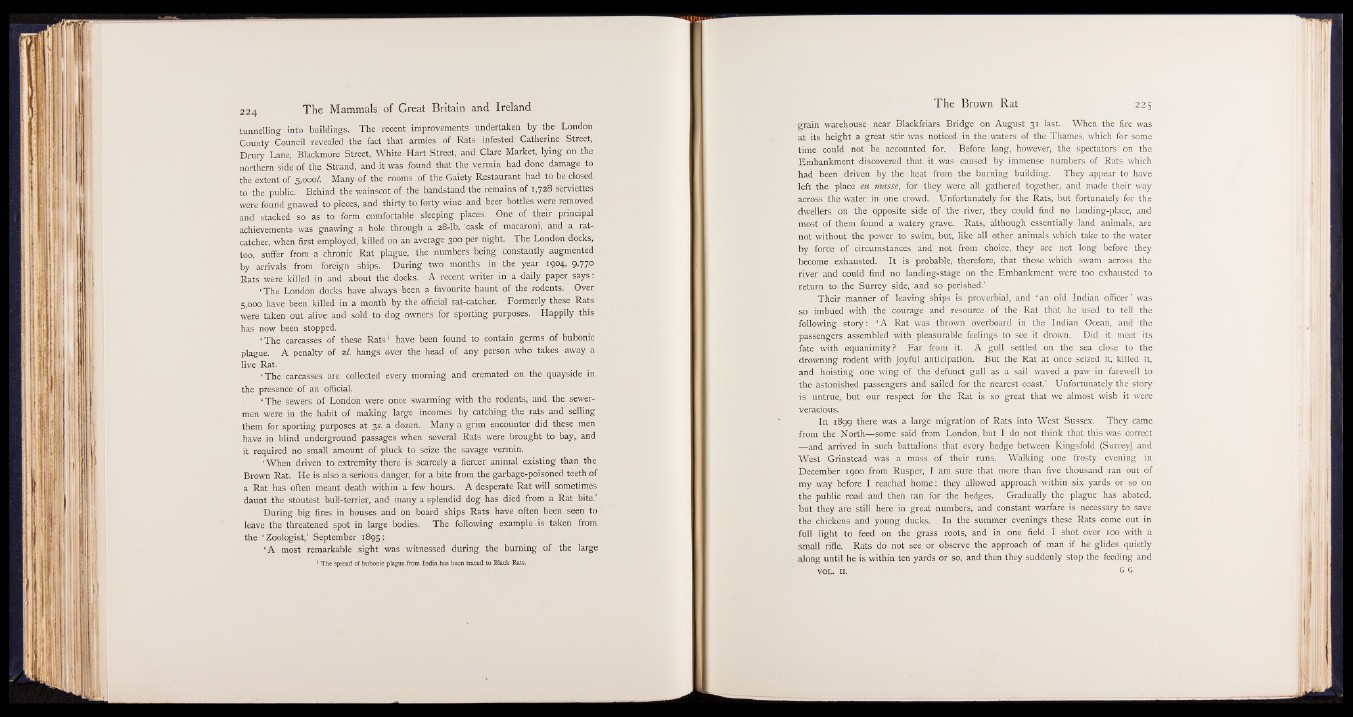
tunnelling into buildings. The recent improvements undertaken by the London
County Council revealed the fact that armies of Rats infested Catherine Street,
Drury Lane, Blackmore Street, White Hart Street, and Clare Market, lying on the
northern side of the Strand, and it was found that the vermin had done damage to
the extent of 5,000/. Many of the rooms of the Gaiety Restaurant had to be closed
to the public. Behind the wainscot of the bandstand the remains of 1,728 serviettes
were found gnawed to pieces, and thirty to forty wine and beer bottles were removed
and stacked so as to form comfortable sleeping places. One of their principal
achievements was gnawing a hole through a 28-lb. cask of macaroni, and a ratcatcher,
when first employed, killed on an average 300 per night. The London docks,
too, suffer from a chronic Rat plague, the numbers being constantly augmented
by arrivals from foreign ships. During two months in the year 1904» 9>77°
Rats were killed in and about the docks. A recent writer in a daily paper say s :
‘ The London docks have always been a favourite haunt of the rodents. Over
5,000 have been killed in a month by the official rat-catcher, Formerly these Rats
were taken out alive and sold to dog owners for sporting purposes. Happily this
has now been stopped.
‘ The carcasses of these Ra ts 1 have been found to contain germs of bubonic
plague. A penalty of 2/. hangs over the head of any person who takes away a
live Rat.
‘ The carcasses are collected every morning and cremated on the quayside in
the presence of an official.
‘ The sewers of London were once swarming with the rodents, and the sewer-
men were in the habit of making large incomes by catching the rats and selling
them for sporting purposes at 35. a dozen. Many a grim encounter did these men
have in blind underground passages when several Rats were brought to bay, and
it required no small amount of pluck to seize the savage vermin.
‘When driven to extremity there is scarcely a fiercer animal existing than the
Brown Rat. He is also a serious danger, for a bite from the garbage-poisoned teeth of
a Rat has often meant death within a few hours. A desperate Rat will sometimes
daunt the stoutest bull-terrier, and many a splendid dog has died from a Rat bite.’
During big fires in houses and on board ships Rats have often been seen to
leave the threatened spot in large bodies. The following example -is taken from
the ‘ Zoologist,’ September 1895:
‘ A most remarkable sight was witnessed during the burning of the large
1 The spread of bubonic plague from India has been traced to Black Rats.
grain warehouse near Blackfriars Bridge on August 3 1 last. When the fire was
at its height a great stir was noticed in the waters of the Thames, which for some
time could not be accounted for. Before long, however, the spectators on the
Embankment discovered that it was caused by immense numbers of Rats which
had been driven by the heat from the burning building. They appear to have
left the place en masse, for they were all gathered together, and made their way
across the water in one crowd. Unfortunately for the Rats, but fortunately for the
dwellers on the opposite side of the river, they could find no landing-place, and
most of them found a watery grave. Rats, although essentially land animals, are
not without the power to swim, but, like all other animals which take to the water
by force of circumstances and not from choice, they are not long before they
become exhausted. It is probable, therefore, that those which swam across the
river and could find no landing-stage on the Embankment were too exhausted to
return to the Surrey side, and so perished.’
Their manner of leaving ships is proverbial, and ‘ an old Indian officer’ was
so imbued with the courage and resource of the Rat that he used to tell the
following story: ‘ A Rat was thrown overboard in the Indian Ocean, and the
passengers assembled with pleasurable feelings to see it drown. Did it meet its
fate with equanimity? Far from it. A gull settled on the sea close to the
drowning rodent with joyful anticipation. But the Rat at once seized it, killed it,
and hoisting one wing of the defunct gull as a sail waved a paw in farewell to
the astonished passengers and sailed for the nearest coast.’ Unfortunately the story
is untrue, but our respect for the Rat is so great that we almost wish it were
veracious.
In 1899 there was a large migration of Rats into West Sussex. They came
from the North—||^me said from London, but I do not think that this was correct
—and arrived in such battalions that every hedge between Kingsfold (Surrey) and
West Grinstead was a mass of their runs. Walking one frosty evening in
December 1900 from Rusper, I am sure that more than five thousand ran out of
my way before I reached home: they allowed approach within six yards or so on
the public road and then ran for the hedges. Gradually the plague has abated,
but they are still here in great numbers, and constant warfare is necessary to save
the chickens and young ducks. In the summer evenings these Rats come out in
full light to feed on the grass roots, and in one field I shot over 100 with a
small rifle. Rats do not see or observe the approach of man if he glides quietly
along until he is within ten yards or so, and then they suddenly stop the feeding and
VOL. 1 1 . G G